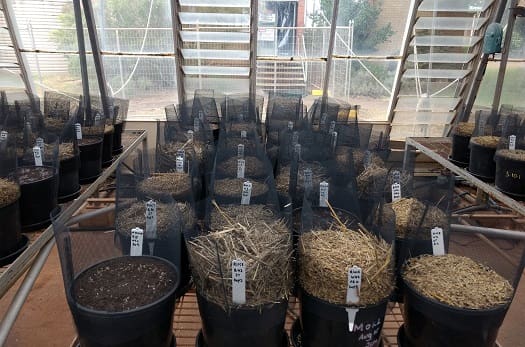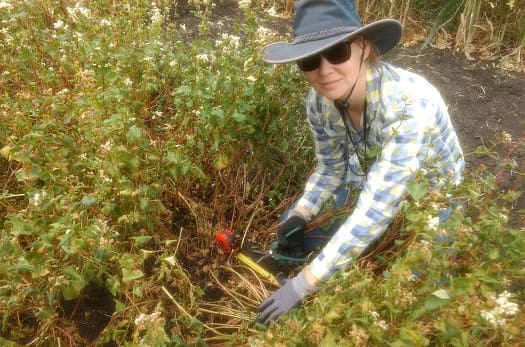Ask a WeedSmart Expert
In the wake of the rapid adoption of chaff lining, the newest harvest weed seed control tool developed by Australian farmers, a substantial research effort has been made to validate the efficacy of the practice.
Chaff lining involves depositing weed seed-laden chaff in a narrow line behind the header.
Some growers using this practice have suggested that as the chaff in the chaff line rots away, much of the weed seed also decays in the process.
Researchers working across the northern grains region have now gained a deeper understanding of what happens to weed seed in a chaff line.
Queensland Department of Agriculture and Fisheries weeds researcher Dr Annie Ruttledge and several collaborating scientists had been looking into different aspects of weed seed decay and weed suppression in the chaff line.
“Non-herbicide tools like chaff lining are very important to help manage the onset and spread of herbicide resistance in weeds,” Dr Ruttledge said.
“The idea with harvest weed seed control tactics is to collect any weed seed present at harvest height, usually above 15 centimetres. With chaff lining, these weed seeds are deposited in a narrow line of chaff behind the harvester.
“Burial in the chaff line can suppress emergence in some weed species, but it does not guarantee that no weeds will emerge from chaff lines,” she says. “Harvest weed seed control tools like chaff lining and chaff tramlining concentrate the weed seed into confined zones where emergence can be monitored and action taken as required, without treating the whole paddock.”

One of the experiments involved determining the level of chaff required to effectively suppress emergence of annual ryegrass and common sowthistle.
Does the chaff line suppress weed emergence?
Short answer: Yes, if the weed seed is buried deeply enough in the chaff. Many weeds in no-till and reduced-till farming systems prefer to germinate on the surface where there is plenty of light.
Longer answer: Our trials investigated the effect of chaff on germination rates of annual ryegrass and common sowthistle. The sowthistle seed was more readily prevented from emerging than annual ryegrass seed, probably due to the different requirements of the species for light. Maximum suppression of annual ryegrass emergence was achieved with a chaff load of 42 tonnes/hectare, which can be feasibly produced in a 3.5t/ha cereal crop. In contrast a chaff load of just 12t/ha of wheat chaff was sufficient to suppress emergence of common sowthistle seed.
Work done by collaborator from Charles Sturt University, Dr John Broster, found that chaff from cereal crops generally provided better suppression of annual ryegrass compared to canola and pulse chaff. For all chaff types the higher the rate per hectare the better the suppression.
What’s the difference in suppression in chaff lines compared to chaff tramlines?
Short answer: Chaff tramlining effectively halves the amount of chaff in each line, potentially reducing the suppressive potential of the chaff.
Longer answer: Placing a single line of chaff behind the harvester (or directing all the chaff from a chaff deck into one tramline) maximises the amount of chaff and therefore the level of weed suppression. Different crop types, sowing rates and crop yield all influence the quantity of chaff produced.
In addition to looking at suppression of emergence, we looked at weed seed decay under field conditions. In these trials there was no evidence that weed seeds rotted more rapidly in a chaff line than on the soil surface.
However, we expect that environmental conditions play a large part in weed seed decay so the results could vary according to season, with more rotting likely in a wet year than in a dry year.
The depth and persistence of chaff cover and the type of weed species are other factors that would influence seed persistence in chaff lines or chaff tramlines.
What are the options for treating the weeds in the chaff line or tramlines?
Short answer: Farmers are leading the way with practical solutions to manage weeds along chaff lines and chaff tramlines.
Longer answer: Some growers use an optical sprayer or a boom with nozzles only operating on the chaff line or tramlines to apply a mix of herbicides that may be too expensive to apply to the entire paddock. Weed seed that is collect at harvest and placed in the chaff line, may have survived in-crop herbicide applications and may be herbicide resistant. Susceptibility testing can help identify herbicides that can provide effective control.
Non-herbicide options are to or wait for germination and chip or trample the weeds. In a mixed farming operation, sheep can graze the chaff lines rendering most of the weed seed unviable, and will benefit from an additional feed source.
Growers who have been using chaff lining and chaff tramlining for several years report that the high concentration of weed seed leads to a high level of competition between the weeds and this is compounded with competition from the following crop. Over time, seed set reduces and any weed seed produced will be collected and returned to the chaff line the following year. When chaff is deposited on the wheeltracks, weeds that emerge face dry, compacted conditions and are often subject to frequent passes with heavy machinery.
……………………………………………………
How to ask a WeedSmart question
Ask your questions about weed control in the chaff line on the WeedSmart Innovations Facebook page WeedSmartAU, Twitter @WeedSmartAU or the WeedSmart website www.weedsmart.org.au/category/ask-an-expert/
‘WeedSmart’ is an industry-led initiative that aims to enhance on-farm practices and promote the long term, sustainable use of herbicides in Australian agriculture.
Annie Ruttledge is a weeds researcher with the Queensland Department of Agriculture and Fisheries.


HAVE YOUR SAY